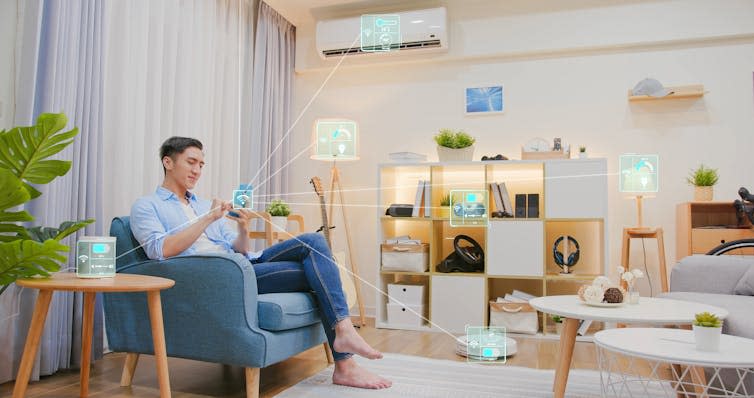Recently, there has been a flurry of publicity about the planned upgrades to OpenAI’s ChatGPT AI-powered chatbot and Meta’s Llama system, which powers the company’s chatbots across Facebook and Instagram.
The technology behind these systems is called a large language model (LLM). These are artificial neural networks, a type of AI designed to mimic the human brain. They can generate general purpose text, for chatbots, and perform language processing tasks such as classifying concepts, analyzing data and translating text.
They acquire these abilities through a rigorous process called training, in which the AI system is exposed to massive amounts of data in an attempt to improve what it does. OpenAI and Meta are expected to release the newer versions of their chatbots – called GPT-5 and Llama 3, respectively – before the end of summer 2024. But how will these differ from their predecessors and what value will they add? ?
Like its predecessor GPT-4, GPT-5 will be able to understand images and text. For example, users will be able to ask her to describe an image, making it even more accessible to the visually impaired.
However, GPT-5 will have better capabilities with different languages, allowing non-English speakers to communicate and interact with the system. This includes a greater mastery of language translation. The upgrade will also have an improved ability to interpret dialogue context and language nuances.
Compared to its predecessor, GPT-5 will have higher reasoning capabilities, meaning it will be able to analyze more complex data sets and perform more sophisticated problem solving. Reasoning will enable the AI system to make informed decisions by learning from new experiences.
Therefore, it will be able to provide users with more accurate information. For example, the system’s improved analytical capabilities will enable it to suggest possible medical conditions from the symptoms described by the user. GPT-5 can process up to 50,000 words at a time, which is double what GPT-4 can do, making it even better at handling large documents.
It will include a higher level of emotional intelligence, allowing for more empathetic interactions with users. This could be useful in a variety of settings, including customer service. GPT-5 will also show a significant improvement in the accuracy of how it searches and retrieves information, making it a more reliable source of learning.
It is said to go far beyond typical search engine functions that locate and extract relevant information from existing information stores, towards generating new content.
GPT-5 is also expected to demonstrate higher levels of fairness and inclusiveness in the content it generates due to additional efforts made by OpenAI to reduce biases in the language model.
It will be able to interact more intelligently with other devices and machines, including smart home systems. The GPT-5 should be able to analyze and interpret data generated by these other machines and incorporate it into user responses. It will also be able to learn from this and aim to provide more tailored responses.

This could enable smarter environments in the home and workplace. GPT-5 will be more compatible with what is called the Internet of Things, where devices in the home and elsewhere are connected and sharing information. It should also help support the concept known as industry 5.0, where people and machines work interactively within the same workplace.
GPT-5 will feature stronger security protocols that will make this version more robust against malicious use and tampering. It could be used to improve email security by enabling users to identify potential data security breaches or phishing attempts.
Overall, the upgrade from OpenAI should be more versatile, more energy efficient in its calculations and should provide a more customizable and personalized service.
Download the update on Meta’s Llama
Llama-3 is Meta’s competitor to GPT-5. It features several improvements compared to its predecessor, Llama-2. It is a more capable model that will eventually come with 400 billion parameters compared to the maximum of 70 billion of its predecessor Llama-2. In machine learning, a parameter is a term that represents a variable in the AI system that can be adjusted during the training process, in order to improve its ability to make accurate predictions.
Llama-3 will also be multi-modal, meaning it can process and generate text, images and video. Therefore, it will be able to take an image as input to provide a detailed description of the content of the image. Likewise, it can automatically create a new image that matches the user’s hint or text description.
It will be able to perform tasks in languages other than English and will have a larger context window than Lama 2. The context window indicates the range of text that the LLM can process at the time the information is generated. This implies that the model will be able to handle larger pieces of text or data in a shorter amount of time when asked to make predictions and generate answers.
Meta is planning to launch Llama-3 in several different versions so that it can work with a variety of other applications, including Google Cloud. Meta announced that more basic versions of Llama-3 will be rolled out soon, before the release of the most advanced version, which is expected next summer.
The transition to this new generation of chatbots could not only revolutionize generational AI, but also usher in a new era in human-machine interaction that could revolutionize industries and societies on a global scale. It will affect how people work, learn, receive health care, communicate with the world and each other. It will make businesses and organizations more efficient and effective, more agile to change, and therefore more profitable.
This article from The Conversation is republished under a Creative Commons license. Read the original article.


Professor Abdul Sadka is the founding Director of Aston Digital Futures Institute, a nationally leading center for research and innovation expertise, developing innovative AI generation solutions to automate industry workflows and improve the quality of customer experience .